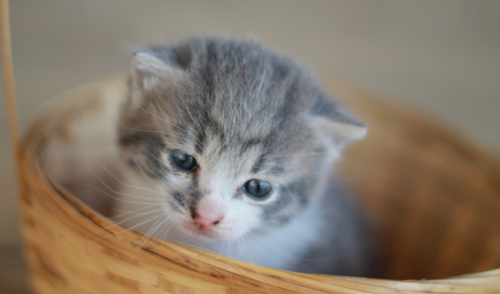
Bottle Feeding Kittens
Newborn kittens require delicate care and specific nutrition to thrive in their first few hours, days, and weeks of life. Ideally, the mother cat should be well-equipped to nurture her kittens, but this isn’t always possible. If necessary, bottle feeding kittens can be a suitable substitute to help give them good beginning for long, healthy lives.
Why Bottle Feeding May Be Needed
There are many reasons why bottle feeding kittens may be necessary. Occasionally, a mother cat may abandon her litter, or be unable to care for her kittens due to injury, disability, or disease. On rare occasions, a female cat may lack the appropriate maternal instinct to adequately nurture a litter, or a litter could be so large that not every kitten will get the appropriate attention. Whatever the reason for helpful intervention, the steps for safe bottle feeding remain the same.
How to Bottle Feed Kittens
It can be intimidating to have helpless, hungry kittens depending on bottle feeding, but establishing the proper routine for feedings can make each meal go smoothly.
- Gather the Proper Supplies Kitten-sized bottles and nipples are essential for safe feedings, and if the kittens are very small or reluctant to suck, a dropper or syringe may be necessary as well. A warm blanket or towel will also be useful to keep the kittens safe and comfortable while feeding. Appropriate supplies can be purchased at pet stores or online.
- Use the Correct Formula Kittens should never be fed cow’s milk, dairy products, or milk alternatives made from soy, almonds, or other foods. Human baby formula is also unsafe for kittens. Kitten replacement formula is necessary to provide these youngsters the appropriate nutrition for healthy growth and immunity. Find this formula at pet stores or from a veterinarian’s recommendation.
- Follow the Proper Schedule How often young kittens need feeding will depend on their overall health, size, and weight. In extreme cases, kittens may need to be fed every 2-3 hours even through the night, though older, stronger kittens can typically go several hours overnight without feeding. Weighing kittens daily can ensure they are being fed adequately to gain weight and grow properly.
- Prepare for the Feeding When it is time to feed the kittens, all bottles and nipples should be thoroughly sterilized, and the feeder should wash their hands as well. Use a warm towel, blanket, or pillow to provide a supportive surface for the kitten, and only feed one kitten at a time so proper attention can be paid to each kitten’s feeding clues.
- Warm the Formula Kittens may reject cold formula and will not get enough nutrition if they don’t eat properly. Warm the formula carefully in a hot water bath, but do not microwave the formula or essential nutrients and proteins will be destroyed. The formula should not have any clumps, and the amount offered to each kitten will depend on the animal’s weight and feeding preferences.
- Hold the Kitten Safely Kittens should be laid on their bellies for feeding, with their heads slightly elevated, just as they would be positioned if they were nursing from the mother cat. Their heads should be at no more than a 30-45 degree angle or there is risk that the formula could enter their lungs and cause infections or breathing difficulties.
- Allow Instinct to Work A healthy kitten will instinctively suckle when presented with a nipple, but if the kitten does not respond, gently stroking their forehead or patting their back can imitate a mother cat’s attention and stimulate their sucking response. Some kittens will nurse more strongly than others, so it is important to be patient and allow them to feed naturally.
- Encourage Burping After the kitten has finished its meal, it should be burped. Gently hold the kitten under its belly and pat its upper back to get a small burp, but do not use vigorous motions that may induce vomiting. One or two small burps is ideal, but not every kitten will burp as easily and if they do not, it is important not to force a burp.
- Clean the Kitten’s Face Spilled formula can cause uncomfortably matted fur and sore skin on a kitten’s face, so be sure to clean up after sloppy eaters. A warm, damp tissue can easily clean up any spilled formula and be sure the kitten is clean and comfortable. Check their paws and chin as well to be sure there are no stray droplets or other dirt or debris that can cause difficulties.
- Stimulate Elimination A mother cat will lick her kittens’ genitals to encourage them to pee and poop. A few minutes after feeding, use a warm, damp cloth or tissue to very gently wipe or jiggle each kittens’ genitals to encourage elimination. Note the color and consistency of their feces to check that their digestion is healthy and consult your veterinarian if there are any abnormalities.
- Naptime! After feeding, young kittens need to sleep to digest the rest of their meal and to conserve their energy for growth. Be sure their bed is clean, warm, and safe, and allow them to sleep between feedings as much as possible. Avoid disturbing the kittens, which can cause stress and fear, hindering their growth and endangering their overall health.
It may take 4-5 weeks of bottle feeding before young kittens are ready to begin weaning. Be patient with their progress, and consult a veterinarian if there are any feeding difficulties. Both the kittens and the feeder will quickly learn what works best, and bottle feeding can be very rewarding both for the kittens who need the assistance as well as the animal lover who has this amazing opportunity to help a young kitten and see it respond so well to each feeding.
